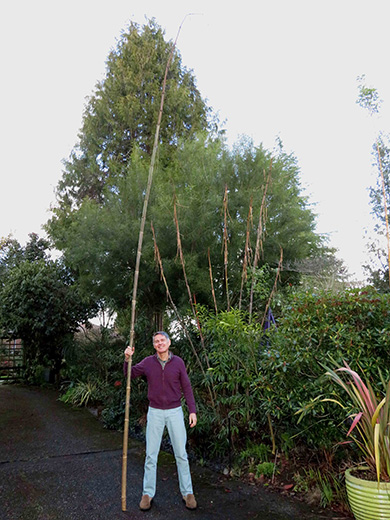
Dahlias in Excelsis
February, 2021
What do our hearts want on this earth? Heart pleasure. Life-Giver, let us borrow your flowers, these golden flowers, these wailing flowers. No one can enjoy them forever, for we must depart.1
—Nezahualcóyotl (1402-1472)
I write these lines fretting (and a bit irritated) about the mid-February meteorological surprise forecast for us. As you read this, we may be in the throes of the first protracted arctic onslaught of the season. That said, I’m determined to focus on dahlias today. Lest you judge me daft for waxing on about tender perennials in the middle of winter, please bear with me. My topic is not the 50,000 or so complex hybrid dahlia cultivars that take center stage in summer and early autumn, but a couple of long-lived, easy to grow, towering species —commonly called “tree dahlias”— that shine later in the season, and sometimes well into February.
But first, let’s consider the origins of these tuberous marvels. Most of the 40 or so Dahlia2 species are endemic to cloud forests of Mexico, although some extend further south into montane areas of Central America. Mexican identity has long been tied to this versatile, variable genus. Today, dahlia is Mexico’s official national flower; half a millennium ago, when the dumbfounded Spanish stumbled upon the dazzling Mexica (Aztec) metropolis of TenochtitIán (today’s Mexico City), they noted the many colors of this flower that adorned spaces both public and private all over the city. They were grown for purposes practical as well as esthetic: all parts are edible (flowers, leaves and tubers), and one species, featured in the next paragraph, boasted canes sturdy enough to serve as water pipes.


The gangly giraffe of the flowering perennial world is the loftily named Dahlia imperialis3. My longest established clump, now 25 years old, each spring sends up half a dozen or so remarkably sturdy, purple-tinged green canes that by December reach twelve to twenty feet in height, if not toppled by the gales of late autumn. Seriously, folks! A few days ago, I sawed down the tallest stalk, whose tip had been nipped by frost and stripped of buds in a January windstorm; it measured 20 feet, 2 inches, not counting the four-inch base left in the ground.

With its rigid, bamboo-like canes and emerald-green pinnate leaves, the “imperial” tree dahlia is a singularly attractive foliage plant. We must make do with this most years, as getting it to bloom in our northerly latitude is a challenge: It doesn’t set buds before November, at which point it’s neck-and-neck to the finish line in a life-or-death struggle with the first frost. On average, in my garden it has successfully opened blossoms about 3 of every 10 years, although the frequency of late has been increasing. This season that 20-footer graced me with a dashing display of fully opened flowers in early December, although I needed a powerful zoom lens to fully appreciate the jaunty blossoms. Several other stalks also set buds, but these either succumbed to frost or were whipped off by the merciless wind. Alas, this is the usual outcome in these parts.


A botanical marvel of a different sort is Dahlia tenuicaulis4, in my experience the most nearly evergreen and frost tolerant of all dahlias. Although considerably shorter than D. imperialis, rising “only” eight to twelve feet, it blooms much earlier (beginning in September or October) than its giant sibling and will power through –or at least stumble– a series of light to moderate frosts that would do in all other dahlias. As I write these lines in early February, I’ve got two clumps in full foliage, still pumping out the odd bloom. The luscious, saturated lilac-magenta blossom portrayed here was photographed in late January. Also a winner is the graceful foliage of this species, with lanceolate leaves that emerge bronze-tinted and age to a lustrous medium green; barring a long, hard freeze it persists well into winter.
On that note, it’s time to acknowledge the reality of impermanence, as Nezahualcoyotl admonished. I’ll take leave and head outside to protect a few more tender beauties from the looming cold. See you in two weeks.
Horticulturally yours,
Daniel
Notes:
- Excerpted from “Melahuac Xopancuicame” (A Plain Spring Song), from Cantares mexicanos, translated from the Náhuatl by John Curl. The author, Nezahualcóyotl (meaning “hungry coyote”), was the governor of Texcoco, 10 miles north of the Mexica (Aztec) capital. Considered the most accomplished poet of ancient Mexico, he also established an arboretum 100 years before the arrival of the Spanish.
- Although the Spanish described in detail the dahlias they observed all over the Valley of Mexico, it took more than 250 years for viable seeds to make it to Europe. The genus was described in 1791 by Antonio Cavanilles of the Royal Botanical Garden in Madrid; he named it to honor a Swedish botanist and student of Linnaeus, Anders Dahl, who had recently died.
- Here’s a Latin term that’s refreshingly straightforward: imperialis = very noble, showy, imperial. The Mexica/Aztecs quite logically called it atlcocotlixóchitl or “water-tube-flower” in recognition of its functional attribute (see photo of cross-section of cut cane).
- Tenuicaulis = “with slender stems” (as opposed to the big bruiser, D. imperialis). The usual common name for dahlias in the Náhuatl language of the Mexica people is aztaxóchitl (meaning “heron flower”). I don’t know if they applied this term to D. tenuicaulis specifically, but as I obtained my specimen of this plant at the original Heronswood Nursery in 2006, I’d like to think so.
